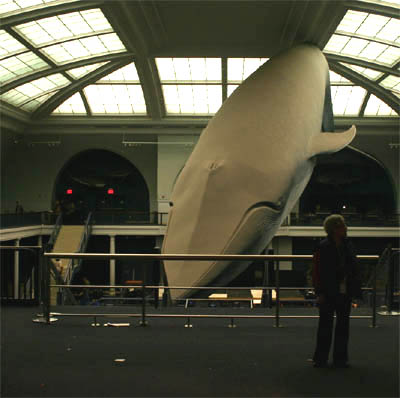 Blue Whale Display American Natural History Museum Photo by Ryan Somma |
Whale-watching businesses use blue whales to sell their product. Documentary-makers use blue whales to sell Nature Films. Nature magazines like National Geographic use blue whales to sell magazines. Marine Biologists use blue whales to learn more about the natural world. Whalers use whales to make sushi.
There are millions of dollars of business and a large number of people who rely on blue whales for their livelihood; therefore, blue whales have a value to everyone, even though no one owns them.
Whalers, in killing blue whales to make their product, prevent other businesses from using those blue whales in their ocean tours, documentaries, articles, and research. If they harvest all the whales from the Ocean, then the other businesses will fail because the whalers have monopolized the entire product.
Garrett Hardin called this the “Tragedy of the Commons.” In a completely free-market system, no one owns the whales, and any one business may drive them into extinction for the sake of profit. In fact, driving whales to extinction is an excellent business model if you want to increase the value of products only obtainable through killing whales. You could hold a monopoly on all such products by harvesting all the whales before anyone else could. Trilobyte fossils sell for hundreds, even thousands of dollars because the Earth discontinued its Trilobyte production millions of years ago. Blue Whales are vastly larger than these pill bugs, and required a great deal more evolutionary R&D before they could grace our oceans.
So we have a natural resource, blue whales, that have a market value to everyone on planet Earth, but the whalers taking this natural resource away from everyone aren’t compensating anyone. In a functioning market, the Whalers would be paying a fee to all the businesses they are depriving of their valuable blue whales.
What’s the value of a single whale? There’s no easy answer to this question, so let’s guestimate a ballpark figure using a cold capitalist calculation:
Let’s pretend there are 1,000 Blue Whales in the Ocean (their actual numbers are estimated at 1,500), and the net-worth of all businesses relying on Blue Whales for their income is $100 Million, probably a gross underestimation, but it simplifies our math. In such a situation, every whale harvested from the Ocean would reduce the ability of Whale-Watchers and Documentarians to find whales by one whale less than 1,000, meaning their businesses have taken a 0.001 percent hit to their productivity because of the Whalers.
To be fair, the Whaling company owes the Whale-Watchers and Documentarians $100,000 for harvesting the one whale. This leaves 999 whales in the Ocean, meaning the next whale they harvest should require them to pay $100,100 to those businesses they are hurting.
This also means they’ll be paying $1 Million or more per whale when their numbers dwindle to 100. As there are less whales in the Ocean, their value increases, and the more cost-prohibitive it becomes to harvest them. Similarly, the healthier the blue whale populations, the less valuable they become.
Despite the reality of the situation, the free market system fails to account for it, and thus an injustice is incurred. Luckily, the free market system is a purely social construct, a game we humans agree to play, and when the rules are unjust, we can adjust them to play fair. We need a market systems that establishes the value of each blue whale and forces companies that remove them for personal use to incur an economic cost for taking them away from the rest of us.
Carbon Credits are a free market system for placing a value on another common resource, clean air. Every ton of pollutants a company puts into our shared atmosphere reduces its quality and our health. Clean air is a commodity that all human being need to survive; therefore, an honest market would place a market value on this finite, shared resource.
There is no economic incentive to build a zero-emissions power plant, but there is an environmental one. There should be a market incentive to improving the environment, because there is a demonstrable market value to the environment.
Runaway consumption of natural resources is a purely capitalist enterprise, while cleaning up the resultant pollutants and restoring ecosystems is mostly a charitable one. Carbon Credits creates such a market incentive. Companies will have an incentive to put their greenhouse gas production into the negative so they make earn additional profits from reversing the effects of global warming.
Carbon Credits are not perfected, but then few capitalist systems are (just look at our current sub-prime mortgage crisis). It will take numerous market adjustments to determine the cost of one ton of CO2, the amount covered in one Carbon Credit, and we should expect much political debate over the value of a carbon credit, what environmentally friendly actions deserve carbon credits, , but that’s a good thing.
This is because the environment is something we all share, and we should all have a say in its value. There is a market value to clean air, water, and biodiversity, but we have to demand it. At this moment, each one of us owns one share out of 6.5 billion shares or 0.000000000153 percent of planet Earth.
It may seem insignificant, until you consider that without your share you die.
This portion of all the Planet’s resources is your birthright as a member of the human race, why let someone else take it for their own profit?
Notes:
Comments
2 responses to “How Much is a Blue Whale Worth? Establishing a Market Value for the Environment”